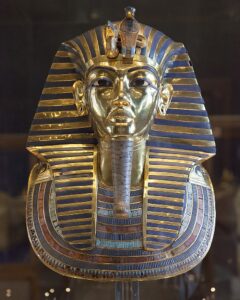The Sojourn and Slavery in Egypt, 1500-1300 BCE
Tutankhamun. By Roland Unger – Own work, CC BY-SA 3.0, https://commons.wikimedia.org/w/index.php?curid=48168958
After the reunification of Joseph with his brothers and his father Jacob, the story of the Israelite people takes a dramatic turn. A new pharaoh “who knew not Joseph” (Exodus 1-8) comes to power who oppresses the Israelites and eventually forces a confrontation that will result in a daring escape from Egypt and the formation of a people forged during a 40-year wandering in the desert. This story of enslavement, the dash to freedom and the eventual entry into the Promised Land dominates the Books of Exodus through Deuteronomy.
The Bible conveys all this in vivid detail- The new pharaoh sets ever harsher quotas on the Israelites for their production of mudbrick; he forces them to find their own straw for the mudbricks that they must manufacture; and finally orders that all newborn Israelite boys be killed.
The most famous of those newborns is Moses, whose mother places him in a basket and sets him afloat on the Nile. Pharaoh’s daughter discovers the child and by a wonderful stroke orders his mother to be the child’s wetnurse. Moses grows up as a prince in Pharaoh’s house, but later witnesses an Egyptian abusing an Israelite. In his anger, Moses kills the Egyptian and flees into the desert. There he comes across another case of injustice when shepherds maltreat a group of women waiting to use a well. He marries one of the women, a daughter of a Midianite priest named Jethro.
Excerpted from Biblical History: From Abraham to Moses, c. 1850-1200 BCE, Steven Feldman, COJS
Overview
- The Mists of Antiquity 2000-1000 BC, Teddy Kollek and Moshe Pearlman, Jerusalem- Sacred City of Mankind, Steimatzky Ltd., Jerusalem, 1991.
- Biblical History- From Abraham to Moses, c. 1850-1200 BCE, Steven Feldman, COJS.
- Moses and the Beginning of Yahwism- (Genesis 37- Exodus 4), Christine Hayes, Open Yale Courses (Transcription), 2006.
Primary Sources
Artifacts
- Descent to Egypt
- The Lion of Hazor, 15th-14th Century BCE
- Statue of the God Ptah-Sokar-Osiris, 1539-1292 BCE
- Thutmose III’s Reliefs at Karnak, 1479-1425 BCE
- The Funerary Temple of Queen Hatshepsut, 1460 BCE
- Trip to Punt, 1460 BCE
- General Djehuty’s Gold Cup, 1455 BCE
- Wall Painting on Plaster, c. 1425 BCE
- Woman Playing the Lute, c. 1400 BCE
- The Amarna Letters, 14th century BCE
- Letter from Yapahu, 14th century BCE
- Baal Stela, 14th-13th century BCE
- Nefertiti’s Head, c. 1370-c. 1330 BCE
- Head of Amenhotep III, c. 1350 BCE
- Amenhotep IV (Akhenaten) Kissing His Daughter, 1352-1336 BCE
- Offering to the Aten, c. 1345 BCE
- Tomb of Haremhab at Saqqara, c. 1330 BCE
- Tomb of King Tutanhkamen, 1323 BCE
- Statue of Horus
- Statue of Khnum
Videos
Articles
- You Too Can Read Hieroglyphics, Carey A. Moore, Biblical Archaeology Review (11:04), Jul/Aug 1985.
- BARlines: Tell el-Amarna Centennial Symposium, Biblical Archaeology Review (12:04), Jul/Aug 1986.
- BARlines: Dayan Collection Opens Amidst Controversy, Biblical Archaeology Review (12:04), Jul/Aug 1986.
- The Monotheism of the Heretic Pharaoh, Donald B. Redford, Biblical Archaeology Review (13:03), May/Jun 1987.
- Were the Ancient Egyptians Black or White? Frank J. Yurco, Biblical Archaeology Review (15:05), Sep/Oct 1989.
- Cow Town or Royal Capital? Nadav Na’aman, Biblical Archaeology Review (23:04), Jul/Aug 1997.
- Pharaoh’s Workers- How the Israelites Lived in Egypt, Leonard and Barbara Lesko, Biblical Archaeology Review (25:1), Jan/Feb 1999.
- Past Perfect: King Tut, I Presume? Archaeology Odyssey (5:4), Jul/Aug 2002.
Maps
Images
- Joseph Recounting His Dreams, Rembrandt (1606-1669).
- Joseph Is Sold by His Brothers, Rembrandt (1606-1669).
- Joseph’s Coat is Shown to Jacob, Rembrandt (1606-1669).
- Joseph Resists Temptation, Rembrandt (1606-1669).
- Jacob Blesses Joseph’s Sons, Rembrandt (1606-1669).
- The Finding of Moses, Paolo Veronese, Oil on canvas, c. 1580.
- The Discovery of Moses, Rembrandt (1606-1669).
- The Finding of Moses, Frederick Goodall (1822-1904).
- Moses and the Burning Bush, Rembrandt (1606-1669).
Websites
- The Amarna Project
- Ancient Egypt – for elementary school students and their teachers. Click here for more Educational Resources for Teachers.
What do you want to know?
Ask our AI widget and get answers from this website
